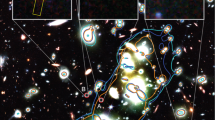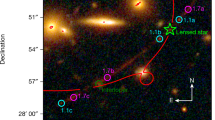Abstract
The radiogalaxy 3C324 has recently raised considerable interest as one of the most distant (redshift z = 1.206) and luminous known galaxies. Here we report new observations of this object at Canada–France–Hawaii Telescope which confirm our previous predictions of the presence of an intervening gravitational lens. First, a multiple structure is revealed by our charge-coupled device (CCD) broadband imagery. Second, following our previous identification in the 3C324 spectrum of an additional line system at z=0.84, subsequent CCD observation through interferential filters were planned. In a wavelength range corresponding to an emission line at z=0.84 only the central component is detected, while only outer components are seen in a range corresponding to a line redshifted by z=1.206. These observations are interpreted as the first example of gravitational multiple imaging of a giant radiogalaxy by a foregound object. So galaxy 3C324 seems to be a gravitational mirage—though further spectroscopic observations will be needed to establish whether the two images have similar spectra.
This is a preview of subscription content, access via your institution
Access options
Subscribe to this journal
Receive 51 print issues and online access
$199.00 per year
only $3.90 per issue
Buy this article
- Purchase on SpringerLink
- Instant access to full article PDF
Prices may be subject to local taxes which are calculated during checkout
Similar content being viewed by others
References
Nottale, L. & Hammer, F. Astr. Astrophys. 141, 144–150 (1984).
Hammer, F. Astr. Astrophys. 152, 262–270 (1985).
Hammer, F. & Nottale, L. Astr. Astrophys. 155, 420–422 (1986).
Hammer, F. & Nottale, L. Astr. Astrophys. 167, 1–10 (1986).
Spinrad, H. & Djorgovski, S. Astrophys. J. 285, L49–L52 (1984).
Hammer, F., Nottale, L. & Le Fèvre, O. Astr. Astrophys. 169, L1–L3 (1986).
Spinrad, H. & Djorgovski, S. Astrophys. J. 280, L9–L12 (1984).
Christian, C., Waddell, P., McGonegal, R. SPEI Proc. no. 627, 500–508 (1986).
Le Fèvre, O. IAU Telegram No. 4233 (1986).
Subramanian, K. & Cowlings, S. A. Mon. Not. R. astr. Soc. 219, 333–346 (1986).
Bourassa, R. R. & Kantowski, R. Astrophys. J. 195, 13–21 (1975).
Refsdal, S. Mon. Not. R. astr. Soc. 128, 295 (1964).
Nottale, L. Astr. Astrophys. 157, 383–386 (1986).
Young, P. Astrophys. J. 244, 756–767 (1981).
Cawthorne, T. V., Scheuer, P. A. G., Morijon, I. & Muxlow, T. W. B. Mon. Not. R. astr. Soc. 219, 883–893 (1986).
Author information
Authors and Affiliations
Rights and permissions
About this article
Cite this article
Fèvre, O., Hammer, F., Nottale, L. et al. Is 3C324 the first gravitationally lensed giant galaxy?. Nature 326, 268–269 (1987). https://doi.org/10.1038/326268a0
Received:
Accepted:
Issue Date:
DOI: https://doi.org/10.1038/326268a0




